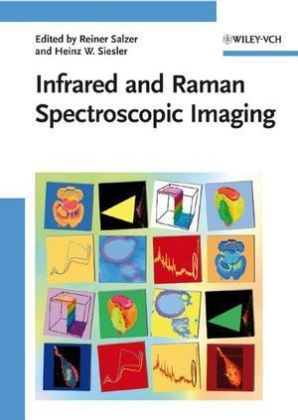
Infrared and Raman Spectroscopic Imaging
Wiley-VCH (Verlag)
978-3-527-31993-0 (ISBN)
- Titel erscheint in neuer Auflage
- Artikel merken
Reiner Salzer retired as Professor of Analytical Chemistry at the Technische Universität Dresden, Germany. He obtained his academic degrees from the University of Leipzig, before taking up his appointment at the TU Dresden. He has authored over 250 books and scientific publications and was elected onto various national and international boards. Professor Salzer is a member of the Norwegian Academy of Science and, a recipient of the Emich Plaque of the Austrian Society of Analytical Chemistry. He is a long-time advisory board member for analytical and spectroscopic journals. Professor Salzer served as President of the Division Analytical Chemistry of the German Chemical Society and is National Delegate to the Division Analytical Chemistry of EuCheMS, where he is Head of the Study Group Education. He was elected as a member of the ECTNA Label Committee for the Chemistry Eurobachelor and Chemistry Euromaster. Heinz W. Siesler has been a professor of Physical Chemistry at the University of Duisburg-Essen, Germany, since 1987. After receiving his PhD in chemistry in 1970 from the University of Vienna, Austria, he worked as a post-doc at the University of Cologne, Germany, and at the Witwatersrand University, Johannesburg, South Africa. Prior to his present position he gained industrial experience as section head in molecular spectroscopy and thermal analysis in the Corporate R&D Department of Bayer AG, Germany. Between 1992 and 2008 he held guest professorships in France, Japan, and Austria. Professor Siesler is a recipient of the EAS Award, the Tomas Hirschfeld Award and the Buechi Award in near-infrared spectroscopy. His main research focuses on the application of vibrational spectroscopy to chemical and polymer research, analysis and quality control, and he has written over 190 publications in this field.
PART I: Basic Methodology
INFRARED AND RAMAN INSTRUMENTATION FOR MAPPING AND IMAGING
Introduction to Mapping and Imaging
Mid-Infrared Microspectroscopy and Mapping
Raman Microspectroscopy and Mapping
Near-Infrared Hyperspectral Imaging
Raman Hyperspectral Imaging
Mid-Infrared Hyperspectral Imaging
Mapping with Pulsed Terahertz Radiation
CHEMOMETRIC TOOLS FOR IMAGE ANALYSIS
Introduction
Hyperspectral Images: The Measurement
Image Preprocessing
Exploratory Image Analysis
Quantitative Image Information : Multivariat Image Regression (MIR)
Image Segmentation
Image Resolution
PART II: Biomedical Applications
VIBRATIONAL SPECTROSCOPIC IMAGING OF SOFT TISSUE
Introduction
Preparation of Soft Tissue for Vibrational Spectroscopic Imaging
Applications to Soft Tissues
VIBRATIONAL SPECTROSCOPIC IMAGING OF HARD TISSUE
Infrared and Raman Spectroscopy of Bone
Infrared and Raman Imaging of Bone
Infrared and Raman Spectroscopy of Cartilage
Infrared and Raman Imaging of Cartilage
INFRARED AND RAMAN SPECTROSCOPY AND SPECTRAL IMAGING OF INDIVIDUAL CELLS
Introduction
Methods
Results and Discussion
3-D IMAGING OF BIOMEDICAL SAMPLES
Introduction
Methodologies
Resultant 3-D Images
PART III: Agricultural Applications
FT-IR MICROSPECTROSCOPIC IMAGING OF PLANT MATERIAL
Introduction, Background and Perspective
Application of IMS to Kernels and Seeds of Plants
Leaves
Application of IMS to Stems and Cellulose Polymers
Algae
NEAR-INFRARED HYPERSPECTRAL IMAGING IN FOOD AND AGRICULTURAL SCIENCE
Introduction
At the Laboratory Scale
At the Industrial Scale
PART IV: Polymers and Pharmaceuticals
FT-IR AND NIR SPECTROSCOPIC IMAGING: PRINCIPLES, PRACTICAL ASPECTS AND APPLICATIONS IN MATERIAL AND PHARMACEUTICAL SCIENCES
Introduction
Instrumentation for FT-IR and NIR Imaging
Applications of FT-IR Imaging for Polymer Research and Quality Control
NIR Imaging Spectroscopy for Quality Control of Pharmaceutical Drug Formulations
ATR-FT-IR IMAGING FOR PHARMACEUTICAL AND POLYMERIC MATERIALS: FROM MICRO TO MACRO APPROACHES
Introduction
The Versatility of ATR-FT-IR Imaging
Applications of ATR-FT-IR Imaging in the Materials Sciences
Applications of ATR-FT-IR Imaging in the Pharmaceutical Sciences
ATR-FT-IR Imaging for Forensic Applications
RAMAN SPECTRAL IMAGING ON PHARMACEUTICAL PRODUCTS
Overview
Hyperspectral Imaging
Empirical Approach to Successful Raman Hyperspectral Imaging
Raman in Multimodal Hyperspectral Imaging
PART V: Developments in Methodology
DEEP, NONINVASIVE RAMAN SPECTROSCOPY OF DIFFUSELY SCATTERING MEDIA
Introduction
Techniques for Deep, Noninvasive Raman Spectroscopy
Examples of Application Areas
Outlook on Raman Tomography
PLANAR ARRAY INFRARED SPECTROSCOPY AND 1-D IMAGING
Introduction
Concept and Instrumentation
PA-IR Spectroscopy
Applications
BIOMEDICAL APPLICATIONS OF INFRARED MICROSPECTROSCOPY USING SYNCHROTRON RADIATION
Introduction
Spatial Resolution Considerations
Advantages of a Synchrotron IR Source
Instrumentation
Biological Sample Preparation and Modes of Data Collection
Biological and Medical Applications on Synchrotron IR Microspectroscopy
Future Directions for Synchrotron IR Microspectroscopy
SPECTROSCOPIC IMAGING WITH NANOMETER RESOLUTION USING NEAR-FIELD METHODS
Introduction
Methods
Applications
Current Challenges
| Erscheint lt. Verlag | 21.4.2009 |
|---|---|
| Sprache | englisch |
| Maße | 170 x 240 mm |
| Gewicht | 1148 g |
| Einbandart | gebunden |
| Themenwelt | Naturwissenschaften ► Chemie |
| Schlagworte | Analytische Chemie • Bildgebendes Verfahren • Infrarotspektroskopie • Raman-Spektroskopie |
| ISBN-10 | 3-527-31993-X / 352731993X |
| ISBN-13 | 978-3-527-31993-0 / 9783527319930 |
| Zustand | Neuware |
| Haben Sie eine Frage zum Produkt? |
aus dem Bereich



